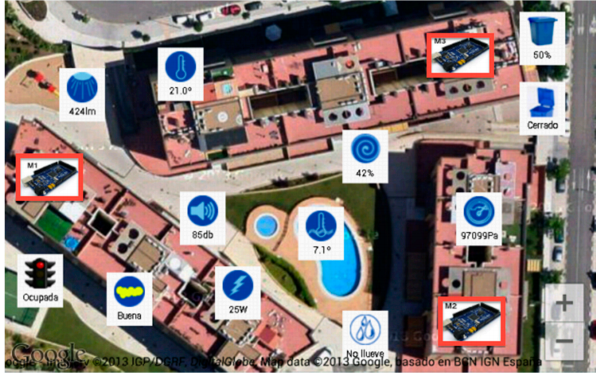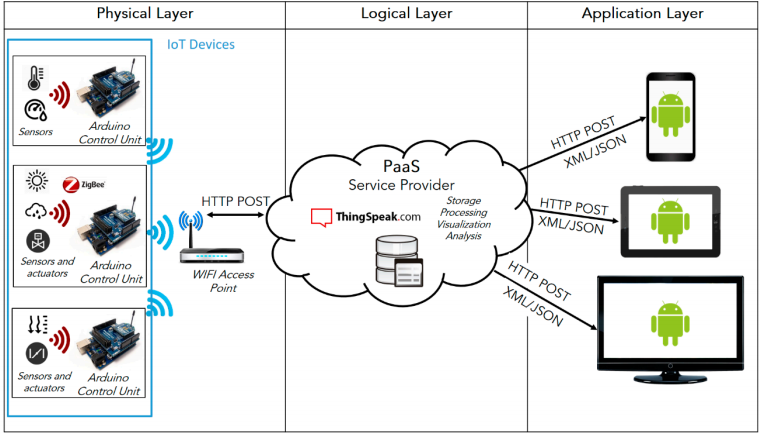ABSTRACT
Internet and, in particular, computer networks have become a key issue in our daily lives, due to the birth of wireless technologies. Internet of Things (IoT) aims to integrate sensors and actuators in daily objects, maximizing miniaturization and minimizing the economic cost of these hardware components. The purpose is to connect these components to the Internet through wireless and fixed networks, and thereby produce information in real time which is then stored for later processing. On the other hand, Interactive TV (iTV) combines traditional TV with interactivity similar to that of the Internet and the personal computer. The evolution of TV technology has brought computing power to this device, offering services apart from the traditional ones, making it a device capable of running applications and maximizing its networking potential.
This work presents a framework that includes and integrates a wireless sensor network, an IoT platform, and a real interactive TV application. It covers the deployment and communication of the wireless sensor network through the interoperability of data, to final consumption, through a real interactive television application. It has been tested within a residential community to provide real-time information, in order to improve the quality of life of its inhabitants. In addition, it incorporates the possibility of analyzing this information to establish processes with the objective of reducing energy consumption, thus improving sustainability and contributing to the efficient use of existing resources. The proposed framework serves as the basis for any deployment of similar characteristics.
TECHNOLOGIES INVOLVED
Figure 1 presents an outline of the interactions that occur between the different entities of the IoT. IoT involves, in the context of wireless sensor networks (WSNs), connecting objects to the Web, allowing them communicating with other devices, objects, and people.
These devices are able to communicate with their environment by exchanging data and information captured and autonomously, reacting to events in the physical world. It is referred to as smart devices or smart things. When we talk about smart devices, we mean any object in our environment capable of capturing and collecting information, transmitting it through the existing network infrastructure, receiving data from the network it belongs to, and acting in certain established conditions.
SYSTEM ARCHITECTURE
The proposed architecture can be seen in the Figure 2, in which you can see the three different layers: physical, logical, and application.
Physical Layer (WSN)
The physical layer is comprised of a WSN, in charge of capturing environmental data for normalization processing and sending them to the logic layer responsible for storage and further processing. The basic components of this layer are sensor nodes. They contain sensors and/or actuators. Sensors can measure physical phenomena such as temperature, humidity, and light, and provide a measurable representation of this phenomenon on a scale or specific range.
Logical Layer
The data generated by the sensors should be processed and stored so that they are persistent and accessible from different networks and for different applications. Given the benefits, the IoT platforms rely on computing environments in the cloud and architectures oriented to a service for storing and processing data, enabling the user to build applications that incorporate these services, forgetting effects on maintenance and how or where they are deployed.
Application Layer
One of the trends in the world of technology is the connected TV. The television has evolved from being “the boob tube” to be an Internet-connected hybrid device capable of running applications that use that connection, employing user interfaces adapted to screen size and interactive interfaces through devices such as remote distance or pointing devices.

Figure 3. Interaction between Smart Residents actors
In the proposed architecture, the data supplied by the sensors is organized in fields, which, in turn, are organized into channels. Figure 3 shows the interaction between different components of the Smart Residents architecture.
DEPLOYMENT SCENARIO AND PROTOTYPE

Figure 5. Location of sensors and microcontrollers in SmartResidents
When the data is ready, the control unit sends it through the Wifi connection, which allows the use of the TCP/IP network infrastructure. This wireless connection can be used in control units because these devices are connected to the electric current, therefore they can meet the energy needs of these connections and produce benefits such as increased bandwidth, ease of configuration, and flexibility in the network. The status of the three microcontrollers can be seen in Figure 5.
As can be seen in Figure 7, the application displays a satellite map located geographically where each sensor appears represented by an identifying icon, next to the last value obtained. This map allows the user to view a visual representation of the location of each sensor. The same information is shown in two vertical navigable menus on the left and right of the map. By processing the data supplied by the logic layer, the application layer interprets the data in accordance with the user interface, in order to display it in a more attractive way.

Figure 8. Smart Residents interface for a specific sensor (Temperature)
Through vertical options from menus and icons on the map, you can access a second screen as shown in Figure 8, through which the application provides more specific statistical data on each of the measurements. Through the form, you can set filter parameters such as date range and time scale. The figure shows a graph with the evolution of temperatures on 16 October 2016, with a time scale of 10 min.
POTENTIAL BENEFITS
Potential benefits of the proposed prototype are derived from the analysis and exploitation of different data analysis techniques, as proposed. For example, by leveraging the capabilities for data analysis offered by the logical layer (Thing Speak), it is possible to react to changes and make decisions that result in improved community services and more efficient management of existing resources. The resources analyzed were as follows:
- Optimization for dumpsters: the data provided by the sensor, placed in dumpsters, records the times when residents throw out the trash and determines the time of collection. The aim is to establish a schedule for the deposit of waste so that the containers are full for the shortest possible time, especially in summer.
- Rationalization of water consumption for watering gardens: the analysis of soil moisture at different times of the year can rationalize the consumption of water by adjusting watering schedules according to the time of the year. In addition, possible future work could include installing sensors in order to activate sprinklers, based on humidity measured in real time.
- Measurement of noise levels: within the established norms for hours in which noise levels should be considerably lower, or respecting the schedules for using the pool in summer. Sound sensors allow continuous logging of noise levels in those areas allowing measurement of the times when noise levels exceed the maximum allowed.
- Optimizing power consumption: sensors enable electricity consumption to be read in real time for different devices. This allows users to adapt their consumption at times when rates are lower. In addition, the light sensors allow public lighting levels to be set depending on the light intensity at a given moment, allowing for a more efficient consumption without being subject to strict schedules.
- Pollution levels: one of the current concerns of city dwellers is environmental pollution. Smart Residents can continuously record pollution levels based on different parameters that provide insightful statistics on times, days, or time intervals of contamination.
- Swimming pool remote measurement: measuring oxidation-reduction potential (ORP), pH, and cloride levels of water can determine if the water quality in the swimming pool is sufficient for recreational purposes. Otherwise, the pool maintenance person will be alerted and will undertake the necessary actions to restore water sanitation.
CONCLUSIONS
Changes in the storage and processing capabilities of increasingly smaller and cheaper devices, as well as communication technologies, have led to a multitude of objects of daily life becoming part of what is known as the Internet of Things, a global network infrastructure and dynamic communication protocol based on open standards, where all kinds of devices called “things” interact and collaborate to achieve common goals. This is the basis for the construction of complex ecosystems where multiple agents interact to provide more efficient services, usually within Smart Cities.
On the other hand, television has evolved into Interactive Television, becoming devices capable of running applications and connecting to the Internet allowing the viewer to enjoy additional services beyond the content provided by conventional television, which is based on one-way communication. Smart Residents introduces architecture for monitoring and automation in residential communities through the integration of paradigms leading to Future Internet.
On the one hand, the Internet of Things, a platform for the collection, transmission, storage and processing of data generated by sensors; and secondly, interactive television that allows access to device information across applications, with simple user interfaces adapted to the particularities of the device. Televisions used as an access device allow new services to be used through a device that has traditionally been used for consumption of TV content, only while leveraging its processing capabilities. Television, thus, becomes a much more active member of the household, a medium through which we interact with our environment.
The proposed architecture for Smart Residents is extendable and scalable, as it is possible to change the size or configuration of the physical layer to adjust to new requirements without adversely affecting the quality of service. The heterogeneity of the nodes in the WSN, and data generated by them, can be saved using a unified and standardized data model to facilitate interoperability. The interaction between the layers is established through a well-defined interface so that changes in one of them do not affect the others.
At present we are working on an update of this IoT ecosystem, in two main lines: first, in the interaction with the inhabitants, through other devices (such as smartwatches with Telegram bots, for example), to alert for inappropriate values of some sensors or failure in some of the nodes of the physical layer; second, we want to improve the physical layer by upgrading the microcontrollers of the sensor nodes to more innovative solutions, like ESP8266 or Arduino MKR1000.
Source: University of Extremadura
Authors: Héctor Sánchez | Carlos González-Contreras | J.Enrique Agudo | Miguel Macías
>> Top IoT Projects using Arduino for ECE Students
>> WiFi based IoT Projects for Engineering Students
>> 50+ IoT based Wireless/GSM Projects for Engineering Students
>> IoT based Real-Time Projects for B.E/B.Tech Students
>> 200+ IoT Led Projects for Engineering Students
>> IoT based Networking Projects for Engineering Students
>> IoT Environmental Monitoring System for Smart Cities Projects


